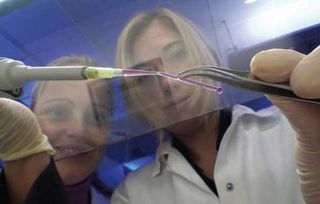Tissue Printer to Fabricate Artificial Blood Cells

3-D printers that fabricate interestingly shaped foods or plastic wrenches certainly have their place, but a new technique that prints out artificial blood cells may take the technology to the next level by actually saving lives. These artificial blood cells represent an important step in the development of artificial organ transplants, since the current generation of artificial organs lack the vascular network needed to function properly.
Designed by scientists at Germans' Fraunhofer Institute, the technique involves printing artificial biological molecules with a 3-D inkjet printer, and then zapping the those molecules with a laser that forms the material into the shape of blood vessels. Like real blood vessels, the artificial vessels have two layers and can form complex branching structures.
"We are establishing a basis for applying rapid prototyping to elastic and organic biomaterials," said Günter Tovar, project manager of the Fraunhofer Institute artificial blood vessel program. "The vascular systems illustrate very dramatically what opportunities this technology has to offer, but that's definitely not the only thing possible."
A 3-D inkjet printer can generate 3-dimensional solids from a wide variety of materials very quickly. It applies the material in layers of defined shape and these layers are chemically bonded by UV radiation. This already creates microstructures, but 3-D printing technology is still too imprecise for the fine structures of capillary vessels. This is why these researchers need the laser.
Brief but intensive laser impulses impact the material and stimulate the molecules in a very small focus point so that linking of the molecules occurs. In this way highly precise, elastic structures are built according to a 3-D building plan.
The later blood vessels have to be elastic and interact with the natural tissue. Therefore, the synthetic tubes are biofunctionalized so that living body cells can dock onto them. The scientists integrate modified biomolecules into the inside walls. In the second step, the cells that form the innermost wall layer of each vessel in the body can attach themselves in the tube systems.
In addition to providing the vasculature for artificial organs, 3-D printed blood vessels could have a medical impact by themselves, serving as organic bypasses for people with clogged arteries or as replacement capillaries for smokers.
Sign up for the Live Science daily newsletter now
Get the world’s most fascinating discoveries delivered straight to your inbox.
Thus far, the Fraunhofer researchers admit that this technology remains in the research phase, a ways away from implementation. However, this advance will almost certainly serve as a accelerator, boosting developments in the related field of 3-D printed organs.
This story was provided by InnovationNewsDaily, a sister site to Live Science. Follow InnovationNewsDaily on Twitter @News_Innovation, or on Facebook.
Most Popular




